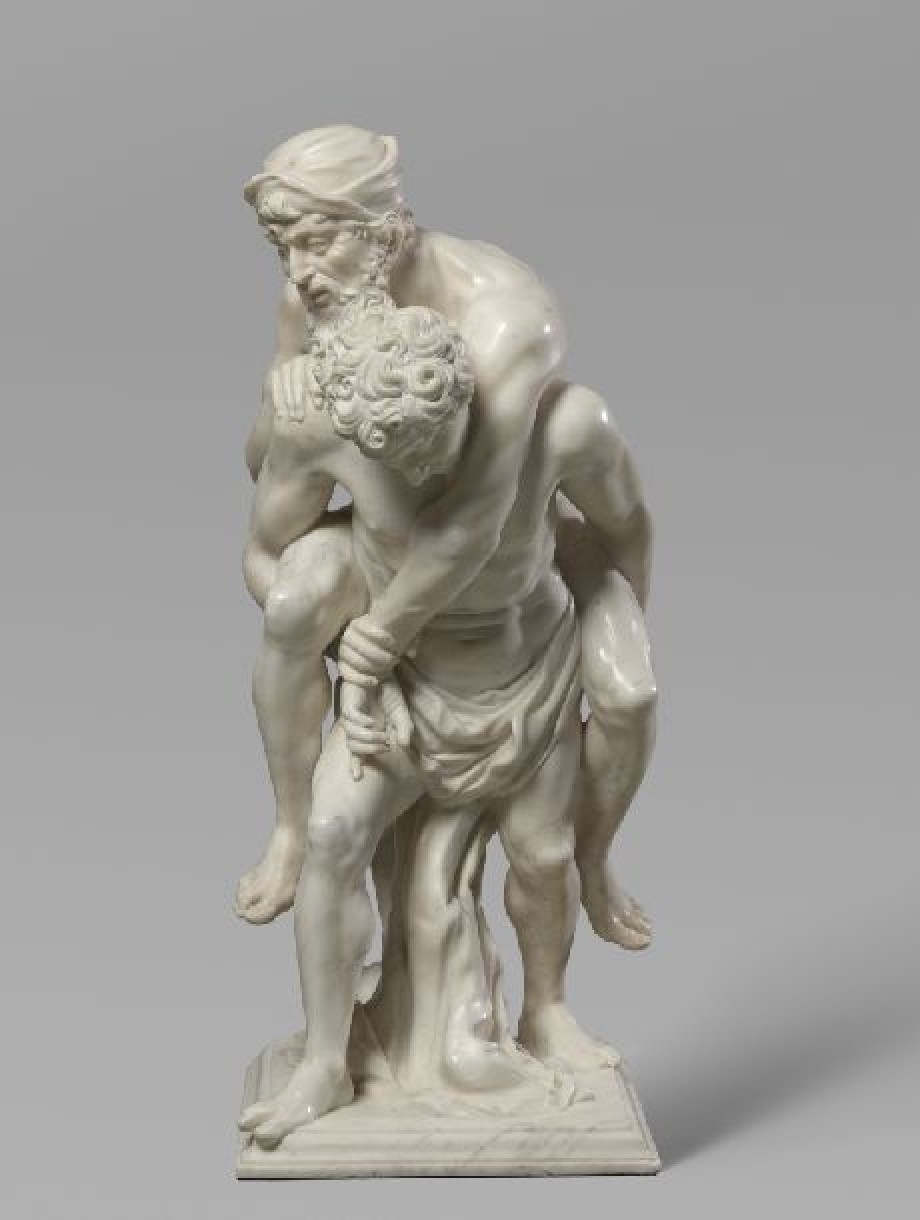
Artus Quellinus I
More about Artus Quellinus I
Artus Quellinus I is an Antwerp sculptor. He comes from an artistic family. His father, the sculptor Erasmus Quellinus I (1584-1640) is his first instructor. Artus is the brother of the painter Erasmus Quellinus II (1607-1678) and the engraver Hubertus Quellinus (1619-1687). Artus I is the instructor of his nephew Artus Quellinus II.
Principally the influence of Classicism via François du Quesnoy (1597-1643), to whom he went for instruction in Rome, is of importance. The influence is expressed in a strict, classicist monumentality. Quellinus studied the ancients in Rome. The sculptor is also inspired by the Realism of Johannes van Mildert (1588-1638) and Lucas Faydherbe (1617-1697).
Very important in his career is the commission for leading the decorative programme for the new City Hall on the Dam in Amsterdam (Royal Palace Amsterdam). The studio in Antwerp was headed by his brother-in-law Pieter Verbruggen I (1615-1686) during his absence.
Portrait busts, such as the famous Portrait of Andries de Graeff, Mayor of Amsterdam (Rijksmuseum, Amsterdam) and Luis de Benavides Carillo, Marquis of Caracena, Governor of the Spanish Netherlands (KMSKA, Antwerp), are a specialty of Artus Quellinus I. The so-called un-posed pose, as if the person being portrayed is captured in a moment's recording, enhances the real-life quality. It is a proof of an influence from Italy, most notably that of Gianlorenzo Bernini (1598-1680). Quellinus is especially technically grounded, which is shown by the high level of Realism and from this the resulting psychology of the person portrayed.
Artus Quellinus I is very influential, and particularly in the Northern Netherlands he has continued to influence the art of sculpture. Quellinus is viewed as the greatest Baroque sculptor in the Southern Netherlands. Joost van den Vondel (1587-1679) calls the artist "Phidias-Quellyn", after the legendary Ancient-Greek sculpture from the 5th Century BCE.
30 August 1609
Artus Quellinus I is born in Antwerp.
Circa 1634
In this period, Quellinus is at work in Rome. According to Joachim von Sandrart, it is his goal to be instructed by François Duquesnoy (1597-1643).
1634
Quellinus is paid by Stadtholder Prince Frederik Hendrik of Orange (1584-1647) for making various works of sculpture, amongst which is a Minerva for the Honselaarsdijk House.
1636
The artist is observed being in Rome.
1639
In a commission by Baltasar Moretus I (1574-1641), Quellinus designs the relief Labore et Constantia, the emblem of the Officiana Plantiniana (Museum Plantin-Moretus/Print Room, Antwerp).
1640-1644
Quellinus establishes himself in Antwerp after a stay of many years in Rome.
1 August 1640
Margriet Verdussen and Artus Quellinus I are married. The artist becomes a Free Master in the Antwerp Saint Luke Guild and takes over the Antwerp studio of his father, Erasmus Quellinus I.
1644
Quellinus completes the Holy Family with Saint Anna for the Antwerp Saint Paul's Church.
Circa 1648
The artist is present in Amsterdam in the capacity of the discussion of the contract for the works in the new City Hall on the Dam by architect Jacob van Campen (1596-1657).
1650-1664
Quellinus establishes himself in Amsterdam and works together with his brother Erasmus Quellinus II. There, for 14 years he leads the decorative sculpture programme for the new City Hall on the Dam (Royal Palace Amsterdam) by architect Jacob van Campen (1595-1657). Among other things, Quellinus makes the monumental frontons on both sides of the City Hall, and above them monumental bronze statues. He makes three large reliefs with 4 grieving and simultaneously excited caryatids in the Vierschaar, or justice hall, and throughout the building provides for the sculptural decoration. Among his assistants we find his nephew Artus Quellinus II.
1656-1657
For the Saint Charles Borromeo's Church in Antwerp, the artist makes Saint Ignatius of Loyola and Saint Francis Xavier.
1658
Quellinus sculpts a Saint Peter for the Saint Andrew's Church in Antwerp. It is one of his most important works in the last period of his career.
1661
The artist makes a marble portrait bust for Andries de Graeff (1611-1678), mayor of Amsterdam. (Rijksmuseum, Amsterdam). This work of art is viewed as one of the most important sculptured portraits from the Baroque in the Netherlands.
1664
Quellinus is back in Antwerp.
For Luis Francisco de Benavides Carillo (1608-1668), Governor of the Spanish Netherlands, Quellinus sculpts a marble portrait bust. (KMSKA, Antwerp).
1665
In this year, Quellinus sculpts the marble portrait bust of the advisory trustee Johan de Witt (1625-1672). Quellinus is paid by the handsome sum of 286 guilders for this.
23 August 1668
Artus Quellinus I dies in Antwerp. He is buried together with his wife Margriet Verdussen in the Friars Minor Church in Antwerp.
(Text: Matthias Depoorter)

